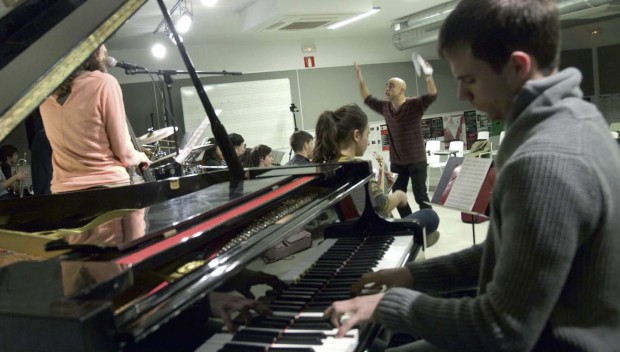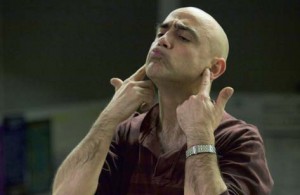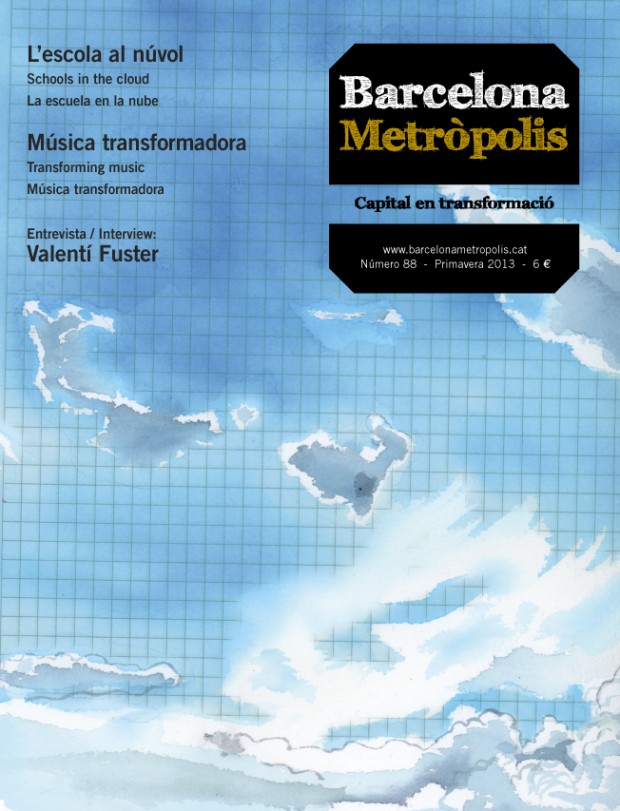The SAJB project is driven by a work ethos that leads its members, children and young people aged between seven and twenty, to play out of need, out of the desire to feel good and convey this to others.

The group during a rehearsal, conducted by the band leader, Joan Chamorro, a tutor at the Musicians’ Workshop.
Today there is no way into the municipal school of music of the Eixample district, as a throng of people of all ages are blocking the entrance. It is hosting a concert by the Sant Andreu Jazz Band, currently the most glamorous children’s and young people’s orchestra, conducted by the jazzman Joan Chamorro. A band with three albums, a documentary and international impact that attracts musicians from all over the world to Barcelona to collaborate in the project.
In the band’s ranks, boys and girls between seven and twenty years old perform a repertoire of jazz, above all swing, from the thirties and forties, with catchy melodies and a rhythm rooted in dance. Where does the SAJB’s magnetism lie? It could be summarised in a single gesture, that of Elsa Armengou, a seven-year-old girl, as she gives the tempo to a twenty-strong orchestra before taking up her own trumpet to play; this, as well as the joy, rhythm and naturalness with which they perform their music from the stage. You can feel that the project is underpinned by a work ethos that leads them to play out of need, the desire to feel good and to communicate this to other people – family, friends and the audience.
How utterly vital these experiences are in our fragile ecosystem! In 2011, the Sant Andreu Jazz Band gave a knockout performance at the Palau de la Música. The SAJB undoubtedly has the hook of being a group where the stars of the show are boys and girls, with the charisma of a voice like Andrea Motis’ to boot. However, if you drop into a rehearsal you will also be charmed by the voice of Magalí Datzira, by Alba Armengou on trumpet and Eva Fernández on saxophone. Besides brimming with good musicians, the SAJB’s great virtue lies in taking classic and popular jazz to audiences who hitherto had never been attracted by this type of music. Glenn Miller, Louis Armstrong and Sarah Vaughan have become part of many people’s soundtrack just as easily as the children take to the stage as another part of their learning process.
The Sant Andreu Jazz Band was founded seven years ago in the municipal music school of Sant Andreu as just another instrumental group, with no intention whatsoever of becoming what it is now. The result is the product of the methodological work of one of their teachers, Joan Chamorro, known for his thirty-year career as a musician, especially as a baritone saxophonist in various bands, and twenty-five years as a teacher. This background allowed him to cultivate an educational experience that is now yielding fruit. Five years on, the SAJB project has surpassed the expectations of the Sant Andreu school, so much so that it is now proving difficult to contain. It is by no means easy for the school to manage a group of students who may start to generate income through the sale of albums and concerts, hence the decision was made to take it outside the school. In 2011, the Sant Andreu Jazz Band became an independent and self-financed project based at the Taller de Música school in the municipal facilities of Can Fabra.
We have to grow
Chamorro fully realises that the goal is not to make money, although this does not mean that the SAJB should exist merely as a school group. “I want the project to grow so that people can see what kind of music children aged nine and twelve years old are capable of making and get other kids to fall in love with it.” The need to explain what is going on in the SAJB is just as compelling as the need the children have to feel that their concerts and music are “real”. As real as the names they refer to constantly during rehearsals or concerts: Billie Holiday, Sidney Bechet, and so on. Is it pretentious for them to attempt to imitate a sound that has captivated them in order to captivate others? This is the traditional method for the transmission of flamenco, or the same one that the son of Alfonso Carrascosa, the latest SAJB member, has grown up with, just like many children of musicians who started to play through imitation, watching and listening to their parents and the friends of their parents who frequented their home.
Instead of mechanically repeating studies and scales, the SAJB children listen repeatedly to the great jazz compositions. Following them and imitating them is their first wish. This is followed by the excitement of being part of a group of friends and musicians, and finally, concerts, sharing stage with such prestigious guests as Jesse Davis, Terell Stafford and Wycliffe Gordon, who became their stage-mates during the concert at the Palau de la Música. If music knows no boundaries, why not let the students cross them beyond the school walls?
Chamorros’ theory is that most of what is learnt in music should come from listening. When a child starts out, they should go straight to the music, the sound, not how it is coded through language, because as yet we do not know if the person will need to use it. Music should come before writing. “It is not a new methodology, but many people are wary of it because, depending on how you look at it, it may be regarded as anti-dogmatic and anti-conservatoire. There are still many things that appear to be immovable. It is taken for granted that children should be grouped by ages or begin to learn through reading and writing music. However, by doing this we are telling the child that they should wait to have a perfect technique to be able to make music or take to the stage. It is believed that most children, particularly smaller ones, cannot climb onto a stage and give a good performance.” Chamorro began to think about recording discs and DVDs to show people what was going on. The first one was with some great friends and musicians from Catalonia such as Ricard Gili, Dani Alonso and Josep Traver, who wanted to participate in the spirit of the SAJB and turn it into a celebration.
Teaching how to love music
“We often hear conversations about how ‘most children do not study’ and teachers would rather work with older students because at “least we can demand more of them”. “This”, explains Chamorro, “is a mistake we have made. Of course there must be willpower and rigour, but what does ‘demand’ mean? The teacher should know how to motivate or encourage children, and before teaching them music, he or she should teach them to love music. You need to make music appeal to children; they should see it as fun. A child will never be motivated to study if we tell them that they will be able to play within a year as long as they study hard. My students start with a song they learn by ear and will be able to play within a week. A note in itself is not important to a child; what they listen to is the melody in their head.”
Tired of years of studying that did not offer students the certainty of being able to play with the same ease as they read a book, Chamorro thought that there was something wrong with the way music was being taught. A teacher of musical language at the Taller de Músics, he developed a colour system to explain tonalities, relationships between notes and other elements of harmony in order to facilitate, among other things, improvisation.
“When you use the actual music without considering the coding of the language, and you do so from your own feelings, you are creating a true connection with the instrument. The results with groups of children aged seven, for example, are amazing. They do not play anything that they do not listen to or sing internally. This is their language. As they study out of pleasure and enthusiasm, they retain things better. And you should hear them improvising! A lot of musicians would have loved to improvise the way these kids do! Only this deep connection with the instrument will make creative musicians of them, a musician who not only reads but also has the ability to sing, to put their fingers in the right place and know what it will sound like.”
So far, eight former members of the SAJB are working in music here or abroad, but regardless of whether they eventually become professional musicians, Chamorro knows that this will have touched their lives forever.




Mis respetos al maestro Joan y felicitación por su extraordinario trabajo.
To Joan Chamorro: your work is priceless. You are revitalizing the Jazz music ( I mean that TRUE Jazz music, not the today’s Jazz without swing, expressiveness, music) that is vanishing in the wprld.. Ettore Zeppegno
charmorro,s teaching methods are obviously working he
was put on earth by god to ensure that jazz never dies
he is doing more to preserve its future than any one else worldwide including the yanks
bonjour à vous.
oui, il y a beaucoup de choses à faire évoluer dans l’enseignement,. qu’importe l’enseignement. je vois tous ses enfants qui pour la plus part, souffre en silence dans nos écoles d’enseignement général. des écoles élitistes aux méthodes révolues et non dynamisante. mes 2 enfants, “surdoué” en on fait les frais tout comme moi en primaire y a 50 ans. j’étais telle heureux de partager avec les autre mes connaissances de la nature et des animaux. j’ai refermé les “portes” après 2 ans dans le primaire. merci super !!!!!!!!!! quand je vois l’école Steiner, Montessori, ou encore la fabuleuse école Russe, de Shchetinin . ou les enfants de 13 ans on atteint le niveau universitaire. comme on dit “ya surement un bins quelque part”. bravo pour l’école de Joan Chamorro et merci.
de plus il a une bonne tête et un très bon esprit. je les ai rencontré au festival de jazz à Chateauneuf du Fou, Finistère France ce WE. génial, captivant, envoûtant ses “p’tits” musiciens et musiciennes. y’avait une foule débridée à écouter leur message musical.merci encore pour ce projet “miracle” pour nos jeunes, et moins jeunes. au Brésil aussi ils applique la méthode globale pour enseigner la musique. j’ai un ami qui joue de la cornemuse depuis sa tendre enfant, inspiré par les anciens. dans le jaz Manouche aussi on voit bien que leur inspiration vient avec l’écoute et l’observation. ce que cela procure à celui qui en joue, ce que ça produit devant les autres. c’est fabuleux et magique… ciao, ciao.
Denis, Breizh
I am 94 years of age, and have played music for the last 80 odd years. My early years was that of playing the music that I hear from the San Andreau repertiore (spelling?) I learned to improvise before I learned to read music and it was the source of my enjoyment of music through the years. Jean Chamorro has captured this love of pure raw music, has recognized the value of the musical period of the Thirties and early forties in the United States, when we then carried it to Europe via the time of our Military engagement there. I listen to the music played by these children with pure pleasure and renewed enthusiasm. Good work Jean C. You have tapped into the real source of musical pleasure and are teaching the way that gets the best out of the Children, and have proven that pure music is elicited from Children with raw talent, rather than being drilled in to them by artificial means. Drills, boring repetitions and promise of future accomplishment. Talent is a NOW thing. and is bursting out all over in Barcelona. It feels like my youth-ful experience in 1930’s America. Bravo to you Jean C. and to Andrea Motis, Eva, Elsa A., who truly amazes me with her talent and intensity and to all the rest of the
assembly of youthful musicians!
I too was completely blown away by the talent and energy in every performer of The Sant Andreu Jazz Band. The quality and range of these musicians is more than the equal of their U.S. counterparts. In fact, my experience suggests that they exceed most young American performers. The ease and skill with which they play suggests a style more often associated with musicians many years older. What is possibly the most remarkable aspect of Sant Andreu is that, rather than the U.S. which for many decades produced scores of talented African American and white jazz musicians, thsre are a group of talented musicians who play as if jazz is all they’ve ever heard from their birth on. And yet, I doubt that before they came under Joan Chamorro’s influence few is any knew little about jazz, it’s traditions, styles and influences. Chamorro has performed what seems like a magic trick, enabling all this talent to emerge from children to young adults and play like that’s what they were born to do. Not since Django Reinhardt has Europe produced this quality of musicianship playing a style of jazz, regrettably, rarely heard today in America. How is it possible to hear the band or its performers or even visit the school for foreigners coming to Barcelona? Felicitats Joan per un notable èxit!
Are you coming to the USA to perform??
I hope you do. There are not enough words of praise for all of you. Muchisimo Gracias
I cannot stop listening – and of course I’m in love with Andrea Motis !!! Your work and inspiration with these “children” is absolutely beyond words. Can’t wait til you play in New York !!! Or I’ll have to go to Barcelona !!!
your effort has a terrific result